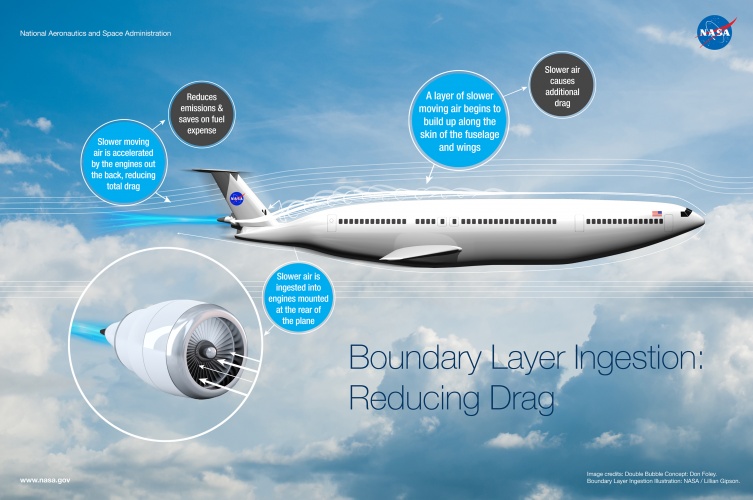The STARC-ABL (single-aisle turboelectric aircraft with aft boundary layer) concept features two underwing engines, slightly smaller than those found on a Boeing 737 today. As well as providing 80 per cent of thrust during takeoff and 55 per cent at cruising altitude, the underwing engines also generate around three megawatts of electrical power. This is used to drive the turbofan at the rear, as well as the plane’s subsystems.
The all-electric BLI (boundary-layer ingesting) ducted fan sucks in the slow-moving air that surrounds the plane’s body, converting it into additional thrust. Overall drag is reduced, and the smaller wing-mounted engines weigh less and require less fuel. According to NASA, the concept could deliver fuel savings of around 10 per cent.

“We believe global competition and international certification standards will drive reduced fuel consumption and more efficient aircraft and propulsion concepts that may use cleaner forms of energy,” said Jim Heidmann, manager of NASA’s Advanced Air Transport Technology Project (AATT). “We also see the potential emergence of alternative modes of commercial transport, such as on-demand and flight service between rarely-traveled locations, both of which would represent new markets and potential beneficiaries of revolutionary propulsion technologies.” Boundary layer conversion will be important for the development of aircraft with engines integrated into the airframe, as discussed in this feature.
READ THE LATEST AEROSPACE NEWS HERE
NASA is preparing for initial ground tests of a subscale STARC-ABL later this year at the space agency’s Electric Aircraft Testbed (NEAT) in Ohio. Here, several challenges will be explored, including how to balance aerodynamic efficiency, optimise the underwing engines and BLI fan, validate the BLI benefits, store energy, compensate for additional weight, and meet safety and operational requirements. NASA also recently awarded 12-month contracts to Boeing, Georgia Tech, Liberty Works and ES Aero to develop additional single-aisle hybrid and turboelectric X-plane concepts.
“As we move forward, we’d like to further develop the powertrains for these and any other concepts that may prove viable by building and testing them at NEAT and other NASA facilities,” said Amy Jankovsky, NASA’s AATT subproject manager.
“We’ll identify key performance parameters for components such as motors, generators and power electronics, and any wind tunnel, altitude and other ground tests and flight demonstrations that are appropriate.”





Swiss geoengineering start-up targets methane removal
No mention whatsoever about the effect of increased methane levels/iron chloride in the ocean on the pH and chemical properties of the ocean - are we...